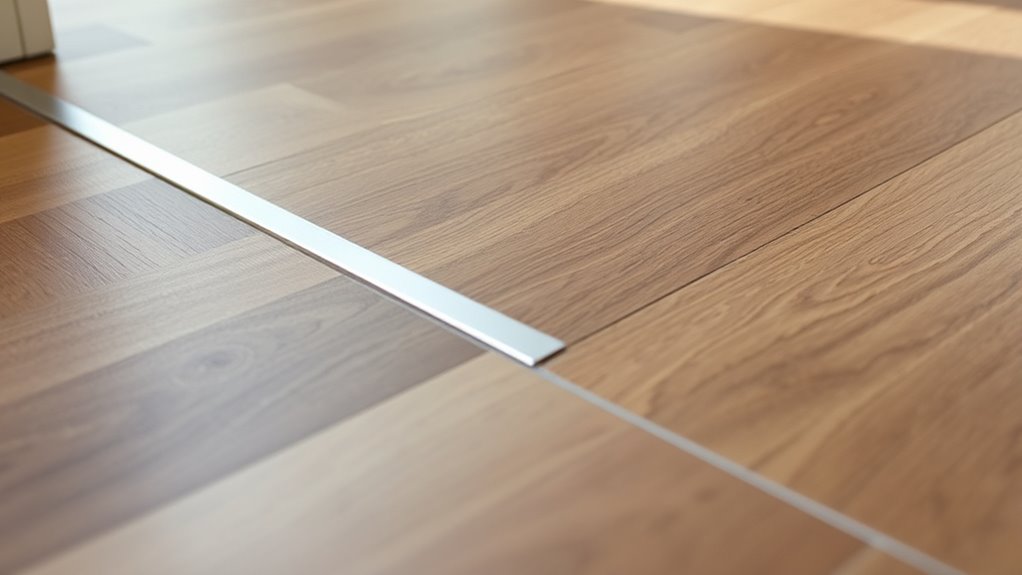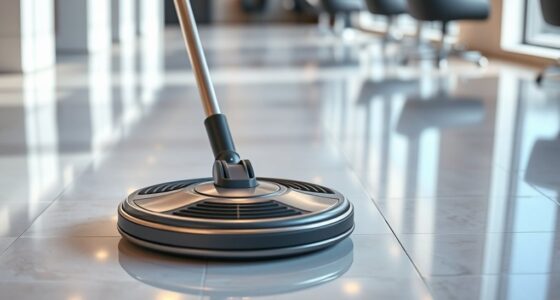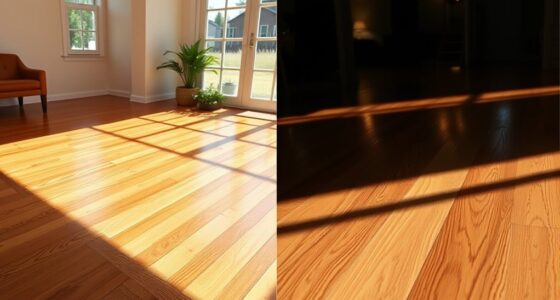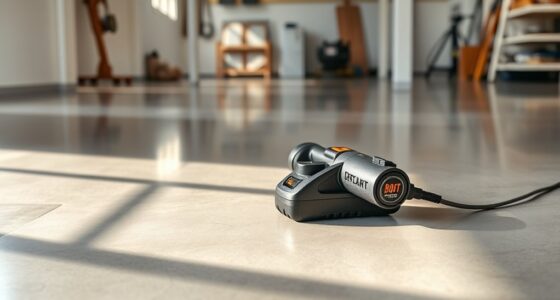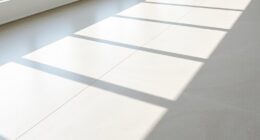To make certain your threshold crossings on laminate floors work well, choose the right type like T-molding or reducers that match your floors’ heights. Use durable materials such as metal or hardwood for longevity. Measure accurately, prepare a flat subfloor, and install thresholds carefully, leaving expansion gaps. Regular maintenance keeps them looking good and functioning properly. If you want tips for seamless, safe crossings, keep exploring how to select, install, and care for your thresholds effectively.
Key Takeaways
- Choose thresholds with adjustable height features to accommodate laminate expansion gaps and uneven flooring surfaces.
- Use durable materials like metal or hardwood for long-lasting, stable crossings that withstand foot traffic.
- Measure accurately and select appropriate threshold types—T-molding, reducers, or flush—to ensure a seamless transition.
- Install thresholds with proper adhesive and secure fasteners to prevent wobbling or gaps over time.
- Incorporate gentle slopes or reducers for smooth, safe crossings between different flooring heights and materials.
Understanding the Purpose of Floor Thresholds

Floor thresholds serve an essential role in creating a smooth passage between different types of flooring, such as from laminate to tile or carpet. They help bridge gaps, prevent tripping hazards, and protect edges from damage. Thresholds also provide a clean, finished look, hiding uneven cuts or transitions. When installed properly, they improve safety by reducing uneven surfaces that could cause slips or falls. Additionally, thresholds can help with expansion and contraction of flooring materials, maintaining stability over time. You’ll find that choosing the right threshold type and installation method makes your space safer and more aesthetically appealing. Understanding their purpose guarantees you select the best solution for your flooring transition, making your home both functional and visually cohesive. Proper installation planning ensures thresholds serve their intended safety and aesthetic functions effectively.
Types of Thresholds Suitable for Laminate Flooring

Choosing the right threshold type for laminate flooring depends on the specific junction you’re making and the look you want to achieve. T-molding is versatile, bridging two floors of similar height smoothly. Reducers are ideal when progressing to lower surfaces like tile or carpet, gently sloping to prevent tripping. Baby thresholds provide a subtle crossing, perfect between rooms with minimal height differences. Flush thresholds sit flush with the floor, creating a seamless appearance, especially in modern designs. Overlap thresholds overlap the edge for added stability and protection, suitable in high-traffic areas. Consider your flooring heights, traffic patterns, and aesthetic preferences when selecting the type. Each threshold offers unique benefits, so choose one that complements both your laminate flooring and the overall style of your space. Additionally, understanding merchant services can help you secure quality thresholds and installation services at competitive rates.
Materials to Consider for Long-Lasting Transitions

Selecting durable materials for your passage thresholds is essential to guarantee they withstand daily wear and tear. The right material ensures longevity and maintains a seamless look over time. Consider these options:
- Metal – Aluminum or brass thresholds are sturdy, resistant to scratches, and add a modern touch. They’re ideal for high-traffic areas.
- Wood – Hardwoods like oak or maple offer natural beauty and durability, blending well with laminate flooring while resisting dents.
- Vinyl – Flexible and water-resistant, vinyl thresholds are budget-friendly and easy to install, making them perfect for humid environments or areas prone to moisture. Natural materials like wood can also provide a more authentic look that complements various interior styles.
Choosing the right material depends on your specific needs and the look you want to achieve, guaranteeing your transition remains functional and attractive for years to come.
Measuring and Planning for Your Thresholds

To guarantee your thresholds fit perfectly, you need to measure accurately and plan their placement carefully. Using proper measurement techniques helps prevent gaps or misalignments, saving you time and effort later. Think strategically about where to position your thresholds for both aesthetic appeal and functionality. Additionally, understanding the types of cookies used on related websites can inform you about how your browsing experience might be affected during your planning process.
Accurate Measurement Techniques
Accurate measurement is essential for planning your thresholds correctly, guaranteeing a seamless shift between different flooring types. To get precise measurements, follow these steps:
- Use a flexible measuring tape to trace the actual contours of the doorway or transition area, accounting for any irregularities.
- Measure the width and height of the opening at multiple points to catch variations, then record the smallest and largest values.
- Double-check your measurements by measuring again or having someone else verify them, reducing the chance of errors.
Taking careful measurements helps you select the right threshold size and shape, avoiding gaps or overlaps. Accurate data simplifies installation and guarantees a clean, professional finish. Always measure twice to ensure your thresholds fit perfectly.
Strategic Threshold Placement
Once you’ve measured your doorway accurately, planning the placement of your threshold becomes straightforward. You’ll want to consider the high-traffic areas and crossings between different flooring types. Position the threshold where it provides the most support and stability, typically at the center of the doorway opening. Think about door swing direction and make sure the threshold doesn’t interfere with movement. If you’re bridging two different floor heights, select a threshold that accommodates the height difference smoothly. Use your measurements to choose the right size and style, guaranteeing it fits snugly and securely. Proper placement not only enhances durability but also maintains a clean, professional look. Planning ahead ensures your threshold functions effectively, providing a seamless transition that stands up to daily use. Additionally, understanding how arcade games work can inspire innovative design ideas for thresholds that incorporate lighted or interactive features.
Step-by-Step Installation Tips for Seamless Transitions
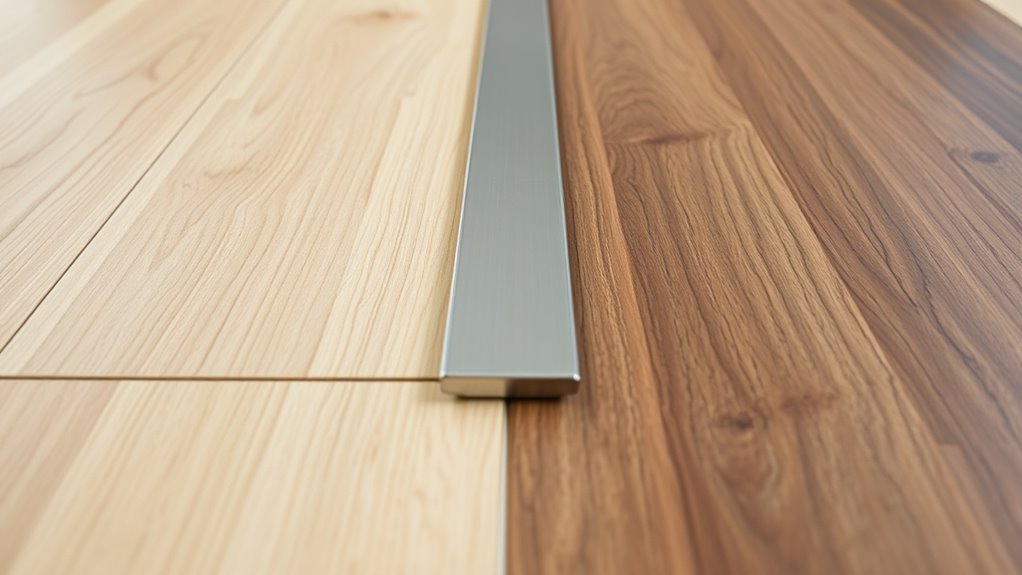
Achieving seamless progressions between laminate floor sections requires careful planning and precise installation. Start by measuring and marking the exact locations for your thresholds to ensure proper alignment. Next, follow these steps:
- Prepare the subfloor by cleaning and leveling it for a flat surface, preventing gaps or uneven transitions.
- Install the laminate planks, leaving expansion gaps along the edges to accommodate movement.
- When fitting thresholds, cut them to match the height of your flooring and secure them firmly, ensuring they bridge the gap smoothly.
- To maintain a consistent look and function, consider using proper flooring transitions that are designed for laminate floors.
Always double-check measurements before cutting or fixing components. Using the right tools and adhesives helps maintain a clean, tight transition. Properly executed, these tips ensure your thresholds create seamless, professional-looking floor crossings.
Common Challenges and How to Overcome Them

While installing thresholds can enhance the look of your laminate flooring, several common challenges can arise during the process. One issue is uneven subflooring, which can cause gaps or misalignment. To fix this, verify the subfloor is level before installation. Another challenge is measuring incorrectly, leading to thresholds that don’t fit properly. Always double-check your measurements and cut the threshold slightly longer rather than shorter. Securing the threshold can also be tricky, especially on uneven surfaces. Use appropriate anchors and adhesive to ensure stability. Finally, dealing with expansion gaps is common; remember laminate flooring needs room to expand. Incorporate a small gap and cover it with the threshold to prevent buckling. Being aware of these challenges helps you plan better and achieve a professional-looking finish. Additionally, understanding how advancements in machine learning can improve tools and techniques may make the installation process easier and more precise.
Maintaining and Caring for Your Thresholds

Ever wonder how to keep your thresholds looking their best over time? Proper care guarantees they stay functional and attractive. First, regularly clean your thresholds with a damp cloth to remove dust and dirt, preventing buildup that can cause scratches. Second, avoid harsh chemicals; instead, use gentle cleaning solutions suitable for laminate and metal. Third, inspect your thresholds periodically for damage or looseness, and tighten or repair as needed. Protect thresholds from impacts by lifting furniture carefully or using felt pads. Keep moisture away by wiping spills immediately, especially around seams. Additionally, understanding the importance of regular maintenance can extend the lifespan of your thresholds significantly. Following these simple steps helps your thresholds withstand daily wear and tear, maintaining both their appearance and functionality for years to come.
Stylish Ideas to Complement Your Laminate Floors

To enhance the beauty of your laminate floors, start by choosing colors and patterns that complement your existing décor. Light-colored floors pair well with neutral tones and soft pastels, creating an airy, spacious feel. Darker laminate options add richness and depth to your space, making bold furniture and vibrant accents stand out. Consider incorporating patterns like herringbone or planks that mimic natural wood textures for added visual interest. Accessories such as rugs, curtains, and artwork should coordinate with your flooring’s hues to create a cohesive look. For a modern touch, use metallic or matte finishes in fixtures and décor pieces. Additionally, eye patch benefits can inspire subtle yet effective ways to refresh and highlight your space, ensuring a stylish, inviting environment that reflects your personal taste.
When to Replace or Repair Your Floor Transitions
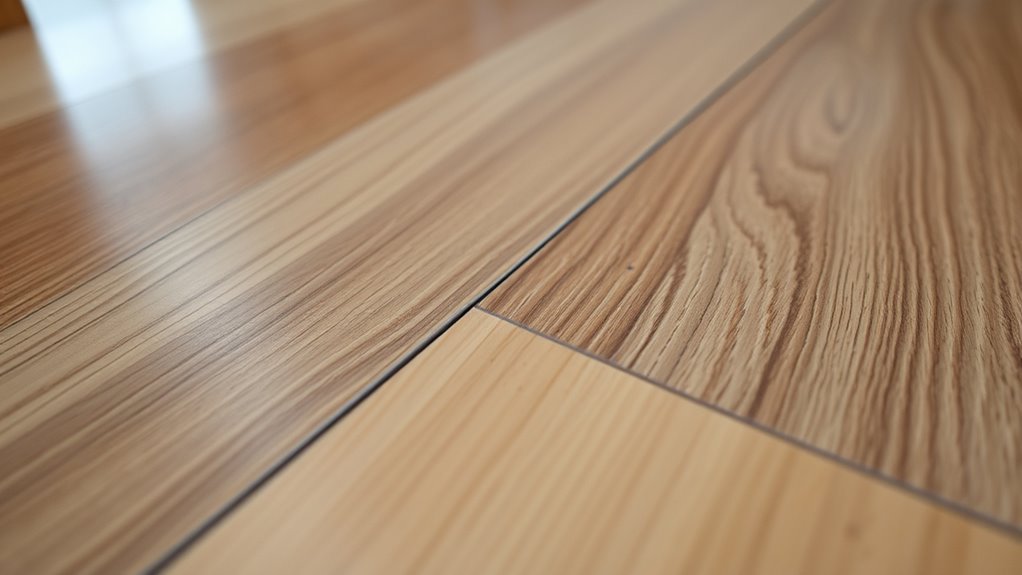
Knowing when to replace or repair your floor crossings is essential for maintaining a seamless and safe laminate floor. If you notice any of these signs, it’s time to act:
- The crossing is cracked, chipped, or visibly damaged, compromising safety and appearance.
- It no longer sits flush with the flooring, causing tripping hazards or gaps.
- The transition feels loose or wobbly, indicating wear or weakened attachment.
- Regular inspections can help identify issues early, preventing water damage or further deterioration. Water damage can compromise the integrity of the flooring and its transitions.
Address minor issues early to prevent further damage. Repair options include tightening screws or applying adhesive. However, if the damage is extensive or the crossing is warped, replacing it guarantees safety and a clean look.
Frequently Asked Questions
Can Thresholds Prevent Floor Squeaking or Movement Over Time?
Thresholds can help reduce floor squeaking and movement over time if installed properly, as they create a stable crossing between surfaces. However, they’re not a guaranteed fix for all squeaks or shifts, especially if the underlying subfloor is uneven or loose. To maximize their effectiveness, make certain the threshold fits well and is securely fastened. Regular maintenance and addressing underlying issues will also help keep your laminate flooring stable and quiet.
Are There Eco-Friendly Threshold Options for Laminate Floors?
Sure, eco-friendly thresholds exist—imagine a world where your flooring choices don’t harm the planet. You can opt for bamboo, cork, or recycled aluminum thresholds that blend sustainability with style. These options minimize environmental impact while providing a sturdy crossing. So, go ahead, make your laminate passage green; your eco-conscious choice will quietly champion the planet, one threshold at a time, without sacrificing durability or design.
How Do Thresholds Affect Wheelchair Accessibility?
Thresholds can impact wheelchair accessibility by creating obstacles or requiring extra effort to cross. To facilitate smooth passage, choose low-profile or beveled thresholds that minimize height differences. Properly installed thresholds with gentle slopes help wheelchair users navigate transitions comfortably. Avoid high or abrupt thresholds, as they can hinder mobility. When selecting thresholds, prioritize options designed for accessibility to make your space inclusive and easy to navigate for everyone.
What Are the Best Thresholds for High-Traffic Areas?
You should choose low-profile, beveled thresholds made from durable materials like aluminum or vinyl for high-traffic areas. These thresholds provide smooth changeovers, reducing trip hazards and making wheelchair navigation easier. Look for options with a height of no more than 1/2 inch to guarantee accessibility. Proper installation is vital, so make certain they’re securely fixed and flush with the flooring to handle frequent foot traffic without damage.
Can Thresholds Be Customized to Match Unique Flooring Patterns?
You can definitely customize thresholds to match unique flooring patterns, and it’s a smart choice—about 85% of homeowners prefer seamless designs. Custom thresholds are crafted to blend perfectly with your laminate floors, mimicking colors, textures, and patterns. You simply work with your supplier or installer to select or create a threshold that complements your flooring, ensuring a cohesive, polished look while maintaining durability and functionality.
Conclusion
Your floor passage isn’t just a crossing; it’s the bridge that ties your space together. With the right thresholds, you’ll create seamless, durable, and stylish connections that last. Embrace the process, plan carefully, and care with confidence—your floors deserve it. After all, isn’t a smooth transition the final touch that turns rooms into a harmonious home? Step confidently forward, knowing your thresholds will stand the test of time.
